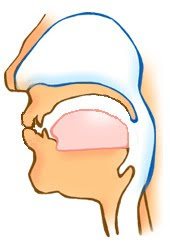Learn English
The Bilabial Nasal
Pronunciation of
- 4.2.1 Bilabial
Bilabial Stops Bilabial stops are produced by the lower lip forming a closure with the upper lip, so that the air cannot escape. The sound occurs when the closure is abruptly released as a puff of air. The stop sounds occur in a pair, i.e. one Fortis...
- 4.1.2 Alveolar
The Alveolar Nasal Production of the alveolar nasal /n/ : The vocal cords vibrate, and the velum is lowered so that the air has to escape through the nose. The tip and front of the tongue form a complete closure against the teeth ridge throughout the...
- 4.1 Nasals
Nasals Nasal sounds are formed with complete oral closure, lasting throughout the production phase. This means that the air has to be let out through the nose. The quality of the sound, however, relates to the mouth closure, and definitions are therefore...
- 3. Teaching Units
Teaching Units The diagramme lists the six groups of sounds that will be described in this course. Two of these belong to the vowel category, i.e. monophthongs and diphthongs, four are consonants. Note that the term vowel is used here for stable sounds...
- 1. Sound Production
The Vocal Organs Speech is produced by the vocal organs. Every language has a definite set of speech sounds, and every sound can be described with reference to the vocal organ that is used to produce it. In this way sounds occurring in different languages...
Learn English
4.1.1 Bilabial
The Bilabial Nasal
Production of the bilabial nasal /m/ : The vocal cords vibrate, and the velum is lowered so that the air escapes through the nose. The lips form a complete closure throughout the production phase.

Pronunciation of
/m/
as in
/maI/ /ti:m/ /ru:mi/
- 4.2.1 Bilabial
Bilabial Stops Bilabial stops are produced by the lower lip forming a closure with the upper lip, so that the air cannot escape. The sound occurs when the closure is abruptly released as a puff of air. The stop sounds occur in a pair, i.e. one Fortis...
- 4.1.2 Alveolar
The Alveolar Nasal Production of the alveolar nasal /n/ : The vocal cords vibrate, and the velum is lowered so that the air has to escape through the nose. The tip and front of the tongue form a complete closure against the teeth ridge throughout the...
- 4.1 Nasals
Nasals Nasal sounds are formed with complete oral closure, lasting throughout the production phase. This means that the air has to be let out through the nose. The quality of the sound, however, relates to the mouth closure, and definitions are therefore...
- 3. Teaching Units
Teaching Units The diagramme lists the six groups of sounds that will be described in this course. Two of these belong to the vowel category, i.e. monophthongs and diphthongs, four are consonants. Note that the term vowel is used here for stable sounds...
- 1. Sound Production
The Vocal Organs Speech is produced by the vocal organs. Every language has a definite set of speech sounds, and every sound can be described with reference to the vocal organ that is used to produce it. In this way sounds occurring in different languages...
